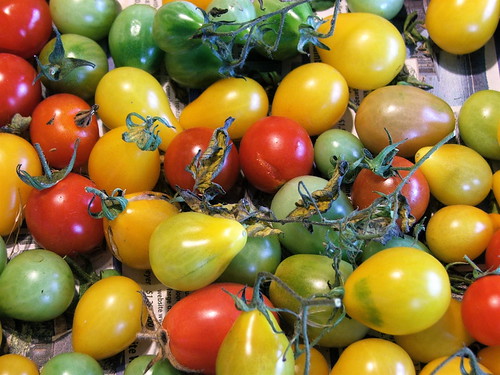Photo By Podchef. Flickr
For the past few summers, I have had to battle with leaf blight infecting my tomato plants. Since organic gardening is very important to me, I make finding an organic solution to my gardening problems one of my number one priorities. I refuse to use anything that may be potentially toxic to the environment or my family. While on my quest to find a homemade fungicide to treat my plants, an easy to make mixture jumped right out at me on an organic gardening sight. I would like to share this recipe with anyone who also practices eco friendly gardening.
All you will need for this all around general fungicide is; a gallon jug full of water with 1 Tbs baking soda, and 2 1/2 Tbs vegetable oil added to it. Shake the jug well. After your done add 1/2 tsp of pure castile soap. pour the mixture into a spray bottle and your ready to go. While spraying your plants, make sure you keep shaking the bottle to keep the mix from separating. Spray both the top and bottom of leaves as well as the soil around the infected plant. Repeat every 7 days.
This baking soda spray can be used to treat anthrocnose, early tomato blight, leaf blight and spots, as well as powdery mildew.



18 comments:
You could also write a gardening book,Lydia. You know so much about organic gardening and plants.
Olivia
Thanks for the idea. I will think about that. Lydia
How about a combined gardening/cookbook?
First you tell how to grow the vegetables organically, then you give the recipe that goes with it.
That might be something new, an original combination that the publisher could find interesting.
Olivia
Sounds like a great idea to me, Olivia. Thank you for all the advise about Llewellyn. I am going to find out about their size standards for the art on the cards. talk to you soon, Lydia
Any idea if this works on peach leaf curl, bacterial canker, or other stonefruit diseases?
We get terrible peach leaf curl, russeting (not sure what is causing that) etc., but I am scared to death to apply the sulfur dormant spray that I have.
Hi,
How is your organic fungicide working out? I am trying to bring a small vineyard back to life and I am trying to do it organically. Do you know if the stuff you are using will work on grapes?
Best wishes,
Tom
i'm working on an organic lawn care regimen and with all the rain and humidity this year, the fungi are decimating my grass. your recipe may just do the trick. thanks for the fungicide tip Lydia.
I've tried Neem on my tomatoes but it hasn't worked, can I use this fungicide after using Neem?
Thanks
This recipe saved the remaining zucchini plants I had left. It hasn't worked for my cucumbers, I pulled those (they seemed to have something different). But I'm really thankful for the great recipe and will always use it now if a zucchini plant starts getting white dusting/spots of fungus. Thank you!
Hi Lydia,
do you think that already cooked olive oil would have the same fungicidal activity? I'm doing an experiment and it's the last mystery unsloved i have, could u give me a hand??
does not work well on powdery mildew. Try potassium bi-carbinate.
If you plan on writing a book, get a good editor. Your spelling is atrocious. Start with "your" vs. "you're" as a lesson and then go onto "advice" instead of "advise." This is not a personal judgment, I'm just saying that you need to have better spelling and grammar if you want educated people to take seriously what you are publishing.
This homemade fungicide would be very helpful to those organic gardeners. Making fungicide that would not harm the environment and the plants is the best solution to the gardening problems. Thanks for sharing this kind of information. It is really necessary to have this kind of idea in organic gardening. Aside from this, it is also important to know that microorganisms should be considered here. Climate conditions and soil preparation also give impact to this method of gardening.
Is there any way to treat the soil prior to planting? I got blight bad in 2009 (as did everyone) but in 2010 I was blight free and got a nice crop! (as did other people). This year however I already have blight. My tomato plants (roma) are not growing very well at all. I'm going to try this remedy but not sure what else I can do. I have a small garden but I make sure to rotate my plants every year. I tried googling soil preparation but haven't come up with much yet. any suggestions?
to treat soil; You can try a Neem Soil Drench; That will kill most soil dwelling pests and fungi; Also you should try Diametceous Earth (aka=D.E.).
I've found you can add to the effectiveness by add 2 aspirins per gallons
Hey as far as organic goes, a friend of mine introduced me to cuh2o. I started using it on my indoor crop and on my squash in the summer. And this stuff is amazing! I can even spray a little on my veggies after harvest and it acts like a preservative! Best of all you can find it on amazon pretty cheap for as long as it lasts
I love your blogs and think it’s wonderful that you are educating people about organic gardening. If you decide to write a book I would be more than happy to proof read for you. As a retired secretary I would have plenty of time to do this for you.
Post a Comment